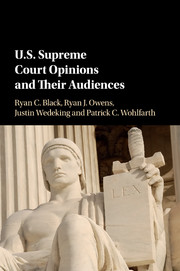Book contents
- Frontmatter
- Dedication
- Contents
- Acknowledgement
- 1 Introduction
- 2 A theory: using opinion clarity to enhance compliance and manage public support
- 3 Estimating the clarity of Supreme Court opinions
- 4 Supreme Court opinions and federal circuit courts
- 5 Supreme Court opinions and federal agency implementors
- 6 Supreme Court opinions and the states
- 7 Supreme Court opinions and the secondary population
- 8 Establishing compliance as a function of clarity
- 9 Conclusion
- References
- Index
7 - Supreme Court opinions and the secondary population
Published online by Cambridge University Press: 05 February 2016
- Frontmatter
- Dedication
- Contents
- Acknowledgement
- 1 Introduction
- 2 A theory: using opinion clarity to enhance compliance and manage public support
- 3 Estimating the clarity of Supreme Court opinions
- 4 Supreme Court opinions and federal circuit courts
- 5 Supreme Court opinions and federal agency implementors
- 6 Supreme Court opinions and the states
- 7 Supreme Court opinions and the secondary population
- 8 Establishing compliance as a function of clarity
- 9 Conclusion
- References
- Index
Summary
In Mapp v. Ohio (1961), the Supreme Court created the exclusionary rule, which held that courts could not admit evidence obtained illegally against a defendant. Chief Justice Earl Warren assigned the Court's majority opinion to Justice Tom Clark, a former Attorney General of the United States, a man responsible for the prosecution of thousands of criminals. In Korematsu v. United States (1944), during the height of World War II, the Court upheld the removal of Americans of Japanese descent to camps away from the West Coast. Chief Justice Stone assigned the Court's opinion to Justice Black, a staunch civil libertarian. These justices seemed unlikely to receive such opinions. But they did receive them. Surely other justices were as qualified. Why did these justices write the opinions? One scholar believes it is because the Chief and other justices were well aware of the need to manage public criticism of the Court's decisions (O'Brien 2008, 273).
The public can be a source of power for the Court, but also a constraint. Public support for the Court enhances its legitimacy. This legitimacy, in turn, gives justices power to rule. Yet frequent rulings against the public could cause it to lose legitimacy. In prior chapters, we demonstrated how Supreme Court justices alter the clarity of their majority opinions with an eye toward multiple audiences in the Court's political and legal environment, including federal circuit courts, federal bureaucratic agencies, and state legislatures. We now extend our focus to a fourth audience – the general public. We examine whether public opinion influences the clarity of Supreme Court majority opinions.
We begin by returning to our central theory – that justices use opinion clarity to enhance compliance with their decisions and, more importantly for this chapter, to manage public support for the Court. We discuss the role of public opinion as a constraint on the Court, highlighting how public opinion influences external actors and, thus indirectly, the Court. We also discuss how frequent rulings against the public could cause the Court to lose institutional support. Next, we discuss why ruling contrary to prevailing popular sentiment might lead justices to write increasingly readable opinions. We then discuss our data and measures, present our results, and conclude with a discussion about the broader importance of public opinion as a constraint on the Supreme Court.
- Type
- Chapter
- Information
- US Supreme Court Opinions and their Audiences , pp. 122 - 140Publisher: Cambridge University PressPrint publication year: 2016

